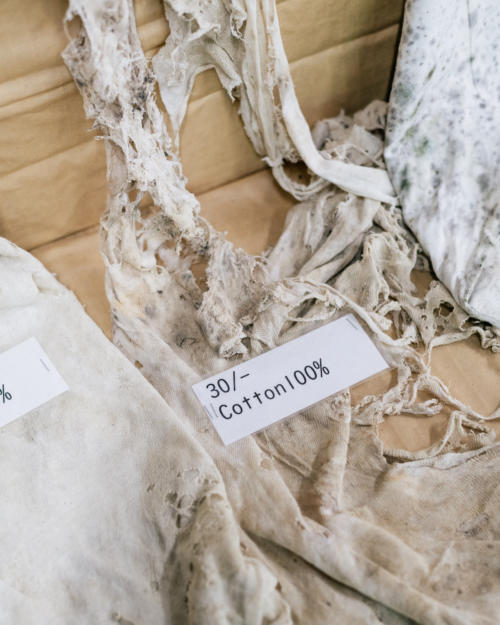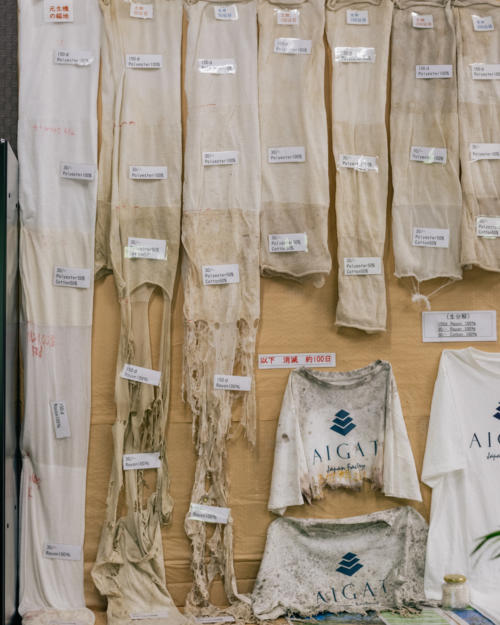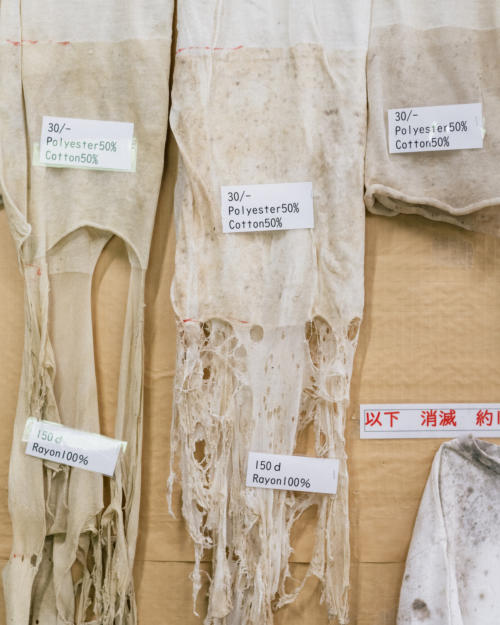How different materials decompose – The Aigat pond

Last week I wrote about the loopwheel knitter Aigat, one of the most specialised producers of loopwheel fabric - for sweatshirts, T-shirts etc - in Japan.
Something I wanted to save for a separate article was the display they had in their reception, where they’d decomposed different fabrics in their garden.
The factory is set in attractive grounds, with water pouring down from the mountains behind. Establishing them, and running the factory along environmental lines, has been a passion of the founder.
In the middle of the garden is a pleasant pond, but a few years ago the team filled the whole thing and parts of the garden with lengths of fabric, made up of different fibres (cotton, rayon, polyester).
The idea was to have personal, physical experience of how much better natural fabrics - like their own - break down in the environment.
The results are displayed in chronological order on the board, below.
The first strip on the left is the original fabric. The strips with red labels at the top are the ones that were buried in the ground (after 50 days, 100 days, 200 days, as labelled), while the blue labels are those that were in the pond (again, after 50, 100 and 200 days).
The strips themselves are then divided vertically into different fibres. First, two different finenesses of polyester, then a polyester/cotton mix, then two finenesses of rayon, and finally cotton.
If you click on the image, it should open in a lightbox, and you can then click on it again to zoom in. Or you can right click and open in a new tab, and zoom in there.
The rayon was the first to go - a synthetic fabric, but of course made with regenerated natural cellulose, so it broke down easily.
The cotton is only just visible, lying on the table at the bottom, but it broke down just a little slower than the rayon, mostly eaten away in the water after 50 days, and completely gone after 100.
But the polyester kept going and going. After 200 days, in water or soil, it had shrunk a little but was otherwise fine.
Perhaps scariest of all is the cotton/polyester mix. You might think this would be a little better than pure polyester, but it's pretty much the same, despite some of the cotton breaking down.
I wasn’t surprised at the results, but it was powerful seeing the process rather than just being told about it.
It also made me appreciate rayon (or viscose) a little more. There are lots of things wrong with it of course, including the materials cut down to make it and the processes used, but it is certainly better than polyester and nylon in this respect. Other natural materials used in high-end menswear, such as wools and vegetable-tanned leathers, are also better in that way.
We probably can't get into all the nuances of material sustainability here - and volume of consumption is generally the biggest issue - but on this one aspect the point is pretty compelling.
Aigat, I should add, only use pure cotton and generate their manufacturing power 60-70% from solar panels on the roof. Actively growing the garden helps a bit with the CO2 emissions as well.
For more on PS about sustainability, see:


































Interesting indeed, but I’m not convinced that faster degradation equals environmental benefits. Does it properly disappear or does it just break up into a multitude of tiny, toxic particles?
I’m not a chemist, but the fact that rayon/viscose is made of cellulose is, as far as I understand it, irrelevant. The source material is turned into a polymer anyway — in other words a plastic. Just like we turn oil (which also was plants originally) into polyester plastic.
Not all plastics are the same, of course, and some are actually biodegradable. Could be an idea for a future article: interviewing someone with technical knowledge on the matter and discussing the impact of things like rayon, “vegan leather”, etc.?
Nice idea, yes.
And it would be good to know that on the way rayon breaks down – any experts please do chip in
It’s important to note that not all polymers are plastics (though all plastics are polymers).
Rayon is a polymer of glucose, and is chemically identical to cellulose (which it’s made from). Cellulose is a structural polymer generated by plants, and given it is made up of sugar (glucose) building blocks, is fully biodegradable. You won’t get “microplastics” as the material will be wholly digested by various organisms (in theory just leaving carbon dioxide and water)
Nearly nothing digests plastic, though plenty of things eat it unfortunately (turtles and plastic bags spring immediately to mind). The plastic just degrades over time into smaller and smaller fragments which then persist in the environment for centuries (varies depending on which plastic and the specific environment).
Sorry if this is unclear. My area is the chemistry, so if anyone has more detail or corrections on the biological side, if be very interested!
That’s very useful, thank you James
Thank you for clearing that up, James; that’s exactly why an expert’s opinion is needed.
If I understand you correctly, rayon is then literally cellulose but turned into a filament? In the same way that, say, an aluminium ingot is chemically speaking the exact same thing as the raw aluminium — in both cases, it’s been “melted” to turn it into another shape, but the chemical composition remains the same. Is that correct?
It would be interesting to know which materials are like this, and which aren’t. And Nils point below about dyes makes me think we should be taking that into account, too (notice that the picture above are of undyed fabrics).
I was going to post about polymers but James is spot on.
I would add a couple of things, there are different types of rayon, and whilst biodegradable, some persist longer than others.
Also rayon manufacture is very environmentally unfriendly, in terms of energy and pollution.
Of course everything we do as an impact, but produced natural fibres seem the best compromise to me.
I also think that would be a very interesting article.
Rayon is a cellulosic polymer and degrades into cellulose, so that’s not harmful. However, many fibers (including natural ones) are treated chemically and at the very least dyed (so I would hesitate to compost any clothing in my backyard in any case!).
I’m finding more and more to like about rayon. Thanks!!
There’s massive attention paid to sustainability and environmental best-practices where I live, in a deep blue (read; lefty) state in the American Northeast. But while issues like bike lanes, organic farming and alternative energy are front and center in public policy and personal habits, the idea of wearing natural fabrics is rarely touched. I’m not sure if wool or cotton lack compelling public mouth pieces for their cause, but that this aspect of the sustainability question hasn’t been more publicly touted has always seemed strange to me.
It’s interesting that in communities like the one in which you live, the environmental concerns often go hand-in-hand with more active, outdoor lifestyles (more people hiking, biking and generally enjoying the great outdoors). With more attention being paid to the use of toxic PFCs and PFAS in waterproof technical clothing (and the general use of synthetics in things like base layers and fleece) and the push to find suitable replacements, I wonder if we’ll see a resurgence of natural fibers in that segment. There are already many companies offering Merino wool base layers, but perhaps we’ll get back to the “good ol’ days” of people trekking in wool sweaters instead of polar fleece and skiing in waxed cotton instead of Gore-tex.
Interesting article, particularly on the cotton/polyester mix which needs to be avoided.
It just so happens that in a secondary school in Belgium they have done this particular experiment a couple of months ago, but taken from a different angle. It was not done to check about which materials break down best, but whether the soil is healthy or not. It depends on the organisms living in the soil whether or not the material can break down or not. It appears a polluted soil without (much) living organisms cannot break down even the best natural material.
Simon,
To digress, do you think it would be interesting to have a series of articles about the impact of significant movies on men’s style ?
A non exhaustive list might include :
North by Northwest
Le Samourai
Bullet
The Thomas Crown Affair
3 Days Of The Condor
Plain Soleil / The Talented Mr Ripley
Phantom Thread
etc…
The idea being to pick out the looks and garments that have had a lasting effect on style.
Regards,
David
Hi David,
To be honest I think I’d rather cover the clothes from the angle of picking particular themes or styles, and then referring to films plural where they fit in. I think sometimes pieces about single films become a bit too narrow or any applicable to one look and period
Simon,
The idea would not be to ‘refer to films’ where a style fits in but rather the reverse – to show how a film created an enduring style.
’Bullet’ is a classic example. McQueen arguably created that louche sports coat, roll neck, slacks and desert boot look. It is referred back to time after time.
It would be so interesting to see features on these looks and their evolution since.
David
Thank you David. Perhaps one to speak to a fashion historian about. Those looks I find were rarely created for the film – as in they were prevalent at the time – but I can see how the film allows the look to last over time.
I think Simon has done a good job of clarifying that the characteristics of the base material are only one factor in the equation. And I think it’s important that he also notes the impact of volume of consumption. Dumping 1 tonne of cheap cotton t-shirts dyed with toxic chemicals into a landfill still isn’t a good thing. Especially if the soil is already saturated with pollutants, as Willem notes. I second Plop’s idea that a more technical article on the subject would be very interesting. Cheers and have a great weekend!
Fascinating article
Only a Japanese company would do this and display the results in their lobby
Just checking in to cheer on both Simon, for highlihting this topic, and on the level of expertise in the commentaries.
This topic is so undercommunicated in the business. Unfortunately to the degree that also «serious» retailers where I live, have caved in to the plastics, -particularly in pants.
A good summer to all of you.
All that I took away from this is that polyester makes for harder wearing clothing.
Consciously provocative as ever Ben. You don’t care what plastic floats around in the ocean or sits under our soil then?
That’s a wild interpretation of my comment.
I did not need this article to inform me about the existence of plastic waste. It’s definitely possible to produce synthetic textiles without adding to plastic waste. And based on the comment below, others drew from this article conclusions similar to mine.
Perhaps, but the comment was obviously deliberately provocative. Of course everyone knows plastic waste exists. But the point of the article, as I said, is that it’s powerful to have it illustrated like that.
You make a good point about synthetic textiles not having to add to plastic waste. That would have been a more interesting and useful thing to say.
Agree with others that this was extremely interesting. Thank you for covering this!
I do posit thought that there’s another way to look at this: presumably those worn down more quickly by water would also wear down more quickly through repeated washings. So a polyester garment would have the potential for a much longer useable lifespan. For someone who takes care of their clothes and wishes to use them a long time, polyester would have an attractive property here. And the long-term usage could be a form of sustainability (requiring less pollution in creating repeated replacements).
Regardless, this is good information to help understand one property of material in deciding what is right for a person.
I don’t think you can really take that away from it, as the situations are so different. And vintage cotton clothing lasts many decades, if it’s good quality and looked after.
I’ve lost 3 cotton dress shirts after 4–7 years of wear to the fabric literally disintegrating in my hands during wash (and I always hand wash/hang dry). I’ve never had this happen with my synthetic stuff, even though I wear the latter much harder—for sports. My cotton t-shirts also tend to develop holes much more easily, often after a handful of washes. So as convenient as it’d be if cotton were to fall in the magic sweet spot between strong enough for clothing but weak enough for the environment, the difference in durability is definitely practical for the consumer to consider.
Sure Ben, and of course less volume overall is also a good. I would suggest it’s worth considering the shirts and T-shirts you buy as well though, as I’ve never had that even close to happen to me
Shirts in question are from RLPL, WWChan (Alumo), and a local tailor (Thomas Mason). T-shirts include Merz ones. All brands have received PS coverage. But that’s not even really the point, is it? All my synthetic shirts cost a fraction of the aforementioned, and what people care about is durability/$.
I don’t know what to say then Ben, I’m surprised they haven’t lasted that well. Obviously it depends how many shirts you have, but even before I was into menswear, pieces didn’t fall apart like that. If you did want to improve that though, perhaps denser and not fine shirts might work well – the fact they’re Alumo and Mason doesn’t mean they’ll last, often quite the opposite if they’re fine.
So here we have another good reason to avoid chinos with elastane.
True
Interesting article and discussion, thank you 🙂
I (sadly) think Ben and Chancellor above raise a relevant point – though perhaps not in the way intended (I can’t read minds so I can only speculate about intentions).
Experiments like this CAN easily be used to argue that artificial materials are better because they don’t degrade: “Polyester will survive washes, sweat and wear much better than these ‘natural materials’, AND it’s cheaper too! You need to buy less clothes, and since volume of manufacture and transportation are the biggest problems, polyester is clearly superior!” Those are compelling arguments for a lot of people – things breaking down quickly is not usually thought of as a good thing! Micro plastics is a hard sell as you can’t see them, and there is still a lack of certainty about the health effects of micro plastics on humans.
Making compelling arguments is tricky, and sadly I think arguments like these is mostly about preaching to the choir; the people who are already convinced natural materials are superior will pat themselves on the back, and the people who aren’t can use the lack of bio-degradability as an argument for artificial materials.
Perhaps we need a good conspiracy theory about micro plastics? The global elite is using it to turn people into robots, and tailoring is the only protection?